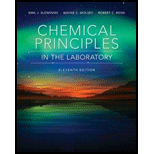
(a)
Interpretation:
To find the electrode where the oxidation is occurring.
Concept introduction:
Oxidation is the loss of electrons or an increase in the oxidation state of an atom, an ion, or of certain atom in a molecule.
Answer to Problem 1ASA
The oxidation occurs at zinc electrode, because the zinc electrode is negative.
Explanation of Solution
The negative electrode in a voltaic cell is taken to be the one from which electrons are emitted (i.e., where oxidation occurs). The negative electrode is the one that is connected to the minus pole of the voltmeter when the voltage is measured.
Therefore, the oxidation occurs at zinc electrode, because zinc electrode is negative.
(b)
Interpretation:
To write the equation for the oxidation half-reaction in the cell.
Concept introduction:
Half-reaction is defined as either the oxidation or reduction reaction of a
Answer to Problem 1ASA
The equation for the oxidation half-reaction is obtained.
Explanation of Solution
Hence, the equation for the oxidation half-reaction of this cell is written as
Therefore, the zinc electrode is considered as the oxidation half-reaction of this cell.
(c)
Interpretation:
To write the equation for the reduction half-reaction in the cell.
Concept introduction:
Half-reaction is defined as either the oxidation or reduction reaction of a redox reaction. A half-reaction is obtained by considering the change in the oxidation states of individual substances involved in the redox reaction.
Answer to Problem 1ASA
The equation for the reduction half-reaction is obtained.
Explanation of Solution
Chemical reactions can be classified as oxidation-reduction reactions, because they involve the oxidation of one species and the reduction of another. Such reactions can conveniently be considered as the result of two half-reactions, one of oxidation and the other reduction.
Hence, the equation for the reduction half-reaction of this cell is written as
Therefore, the copper electrode is considered as the reduction half-reaction of this cell.
(d)
Interpretation:
To write the net ionic equation for the spontaneous oxidation-reduction reaction that occurs in the cell.
Concept introduction:
The net ionic equation is obtained by combining both oxidation and reduction-half reactions in this cell.
Answer to Problem 1ASA
The net ionic for the spontaneous oxidation-reduction reaction is obtained.
Explanation of Solution
When we connect a voltmeter between the two electrodes, we will find that there is a voltage, or potential, between them. The magnitude of the potential is a direct measure of the chemical tendency, or more properly the
Hence, the net ionic for the spontaneous oxidation-reduction reaction that occurs in this cell is written as
Therefore, the oxidation and reduction reaction of zinc and copper electrode is considered as the net ionic equation of this cell.
Want to see more full solutions like this?
Chapter 32 Solutions
Chemical Principles in the Laboratory
- Halide ions can he deposited at a silver anode, the reaction being Ag(s) + X- AgX(s) +e- Suppose that a cell was formed by immersing a silver anode in an analyte solution that was 0.0250 M Cl-,Br-, and I -ions and connecting the half-cell to a saturated calomel cathode via a salt bridge. (a) Which halide would form first and at what potential? Is the cell galvanic or electrolytic? (b) Could I- and Br- be separated quantitatively? (Take 1.00 l0-5 M as the criterion for quantitative removal of an ion.) If a separation is feasible, what range of cell potential could he used? (c) Repeat part (b) for I- and Cl-. (d) Repeat part (b) for Br- and Cl-.arrow_forwardThe saturated calomel electrode. abbreviated SCE. is often used as a reference electrode in making electrochemica1 measurements. The SCE is composed of mercury in contact with a saturated solution of calomel (Hg2Cl2). The electrolyte solution is saturated KCI. is +0.242 V relative to the standard hydrogen electrode. Calculate the potential for each of the following galvanic cells containing a saturated calomel electrode and the given half-cell components at standard conditions. In each case. indicate whether the SCE is the cathode or the anode. Standard reduction potentials are found in Table 17.1. a. Cu2++2eCu b. Fe3++e-Fe2+ c. AgCl+e-Ag+Cl- d. Al3++3eAl e. Ni2++2eNiarrow_forwardA galvanic cell is based on the following half-reactions: In this cell, the copper compartment contains a copper electrode and [Cu2+] = 1.00 M, and the vanadium compartment contains a vanadium electrode and V2+ at an unknown concentration. The compartment containing the vanadium (1.00 L of solution) was titrated with 0.0800 M H2EDTA2, resulting in the reaction H2EDTA2(aq)+V2+(aq)VEDTA2(aq)+2H+(aq)K=? The potential of the cell was monitored to determine the stoichiometric point for the process, which occurred at a volume of 500.0 mL H2EDTA2 solution added. At the stoichiometric point, was observed to be 1 .98 V. The solution was buffered at a pH of 10.00. a. Calculate before the titration was carried out. b. Calculate the value of the equilibrium constant, K, for the titration reaction. c. Calculate at the halfway point in the titration.arrow_forward
 Chemical Principles in the LaboratoryChemistryISBN:9781305264434Author:Emil Slowinski, Wayne C. Wolsey, Robert RossiPublisher:Brooks Cole
Chemical Principles in the LaboratoryChemistryISBN:9781305264434Author:Emil Slowinski, Wayne C. Wolsey, Robert RossiPublisher:Brooks Cole ChemistryChemistryISBN:9781305957404Author:Steven S. Zumdahl, Susan A. Zumdahl, Donald J. DeCostePublisher:Cengage Learning
ChemistryChemistryISBN:9781305957404Author:Steven S. Zumdahl, Susan A. Zumdahl, Donald J. DeCostePublisher:Cengage Learning Chemistry: An Atoms First ApproachChemistryISBN:9781305079243Author:Steven S. Zumdahl, Susan A. ZumdahlPublisher:Cengage Learning
Chemistry: An Atoms First ApproachChemistryISBN:9781305079243Author:Steven S. Zumdahl, Susan A. ZumdahlPublisher:Cengage Learning Chemistry: Matter and ChangeChemistryISBN:9780078746376Author:Dinah Zike, Laurel Dingrando, Nicholas Hainen, Cheryl WistromPublisher:Glencoe/McGraw-Hill School Pub Co
Chemistry: Matter and ChangeChemistryISBN:9780078746376Author:Dinah Zike, Laurel Dingrando, Nicholas Hainen, Cheryl WistromPublisher:Glencoe/McGraw-Hill School Pub Co





